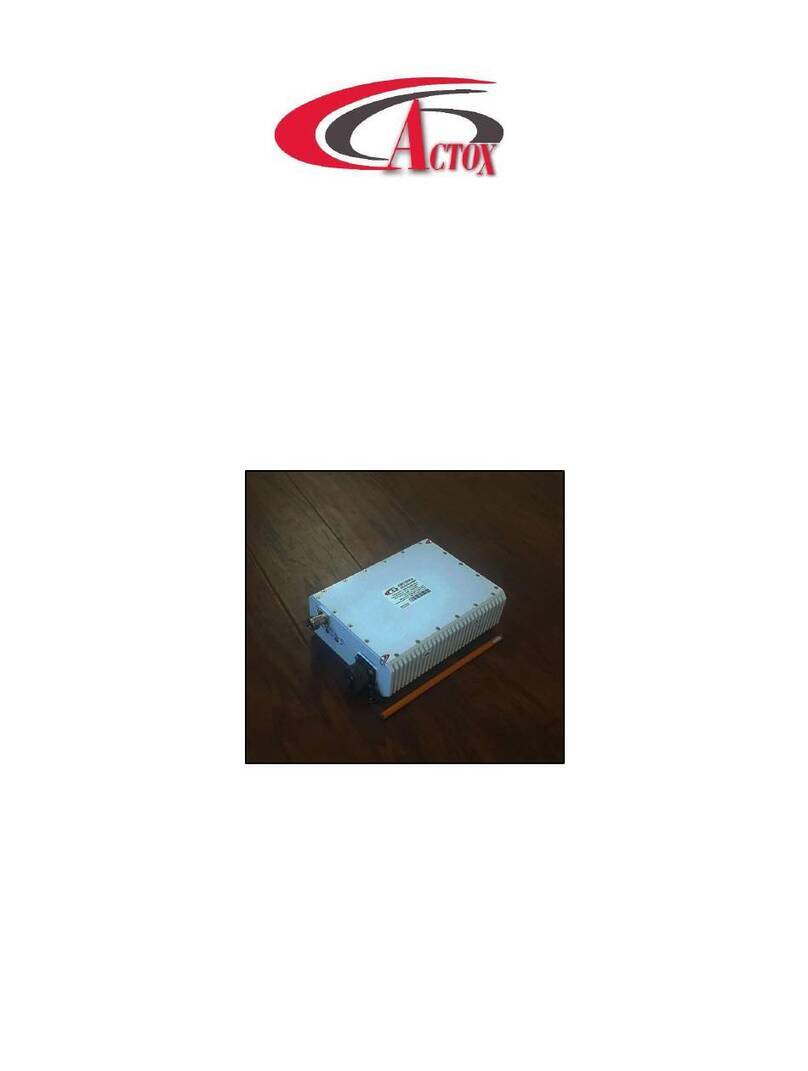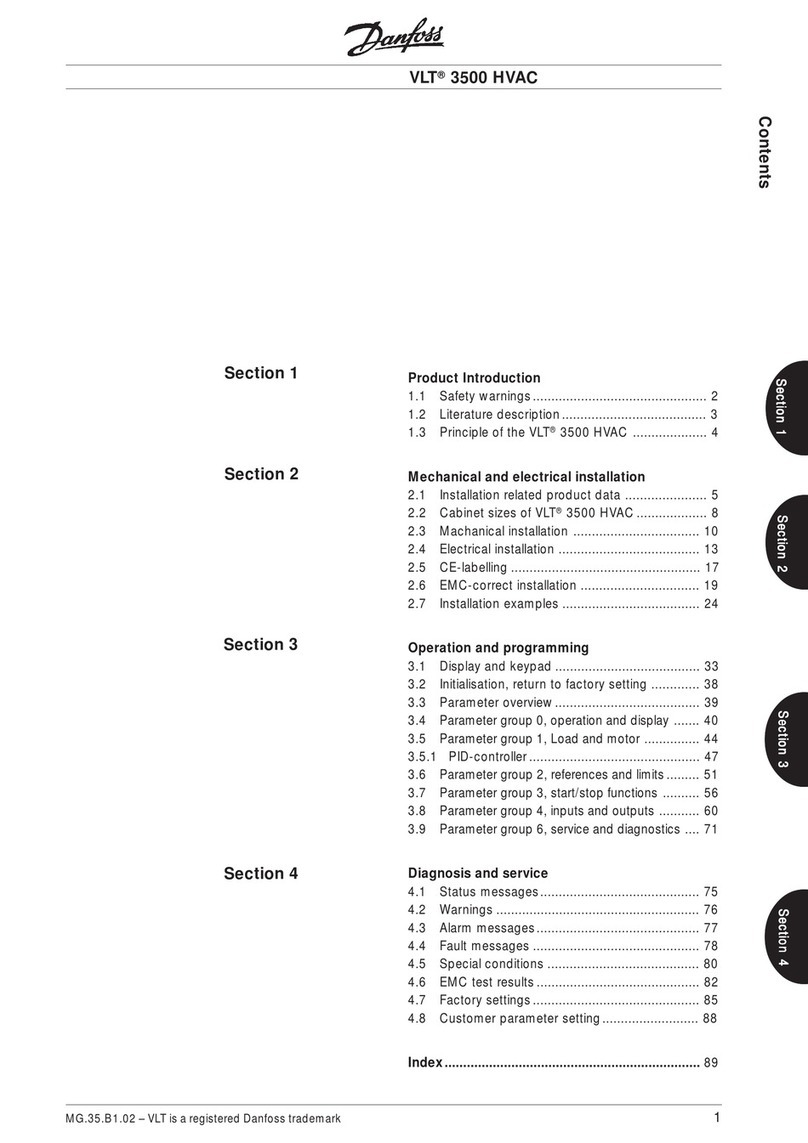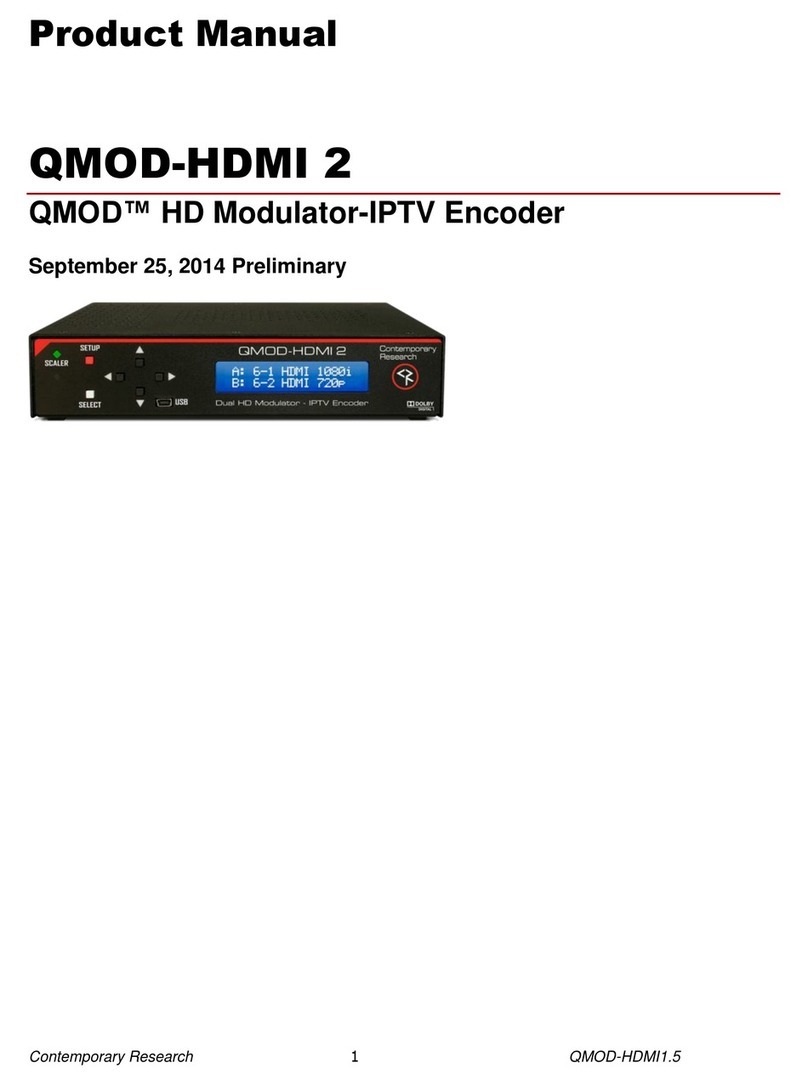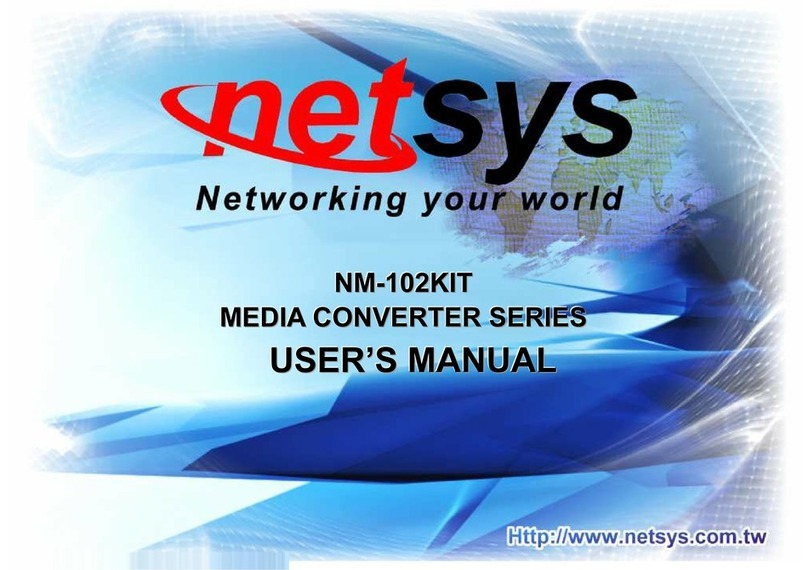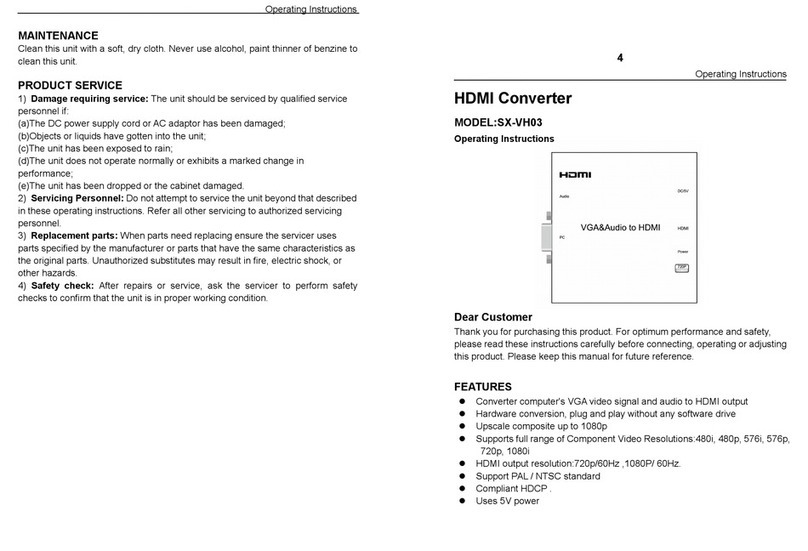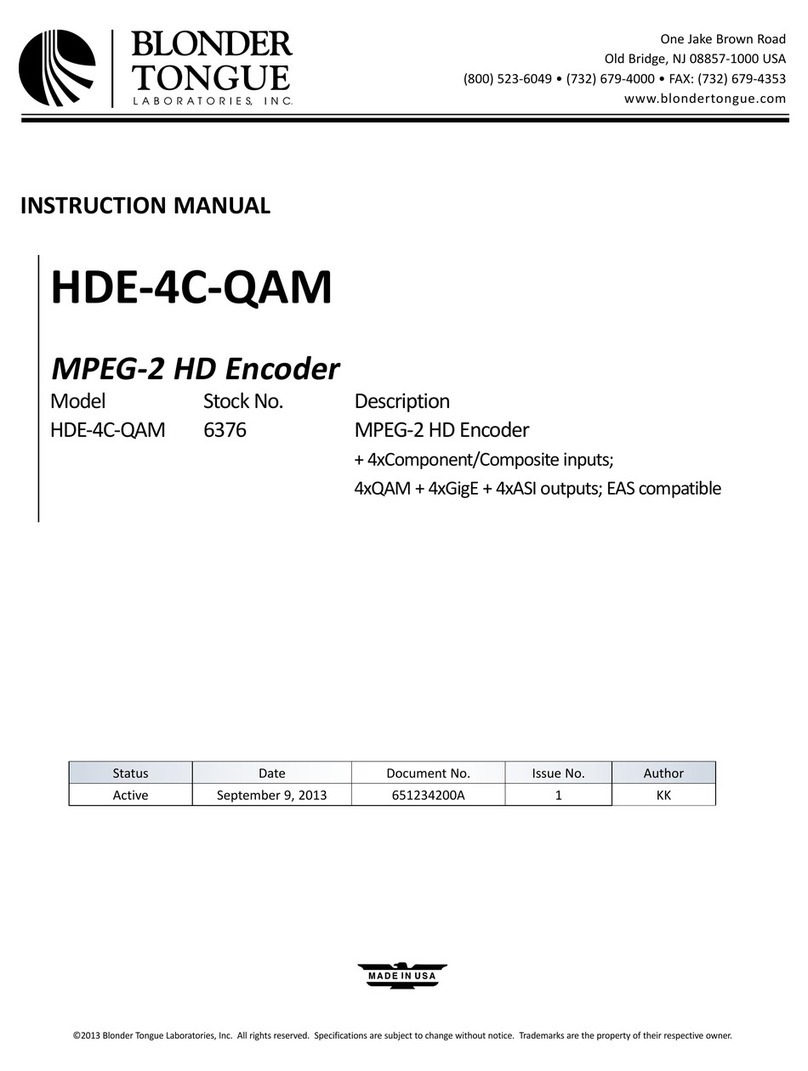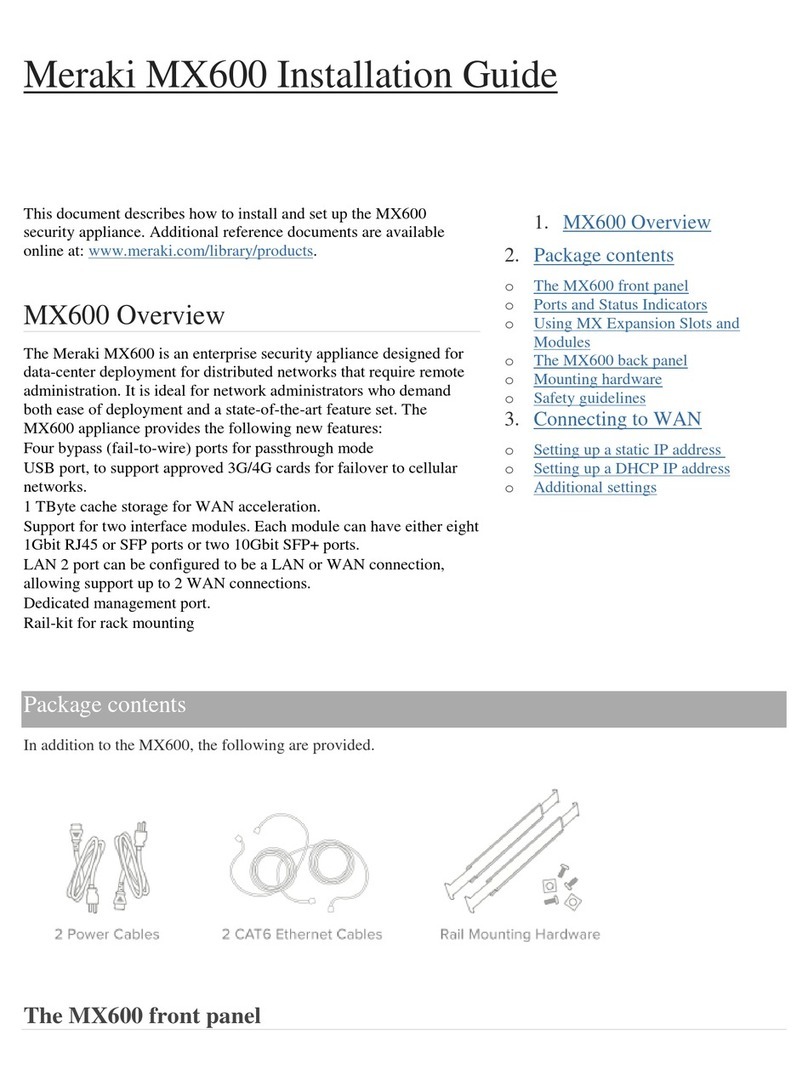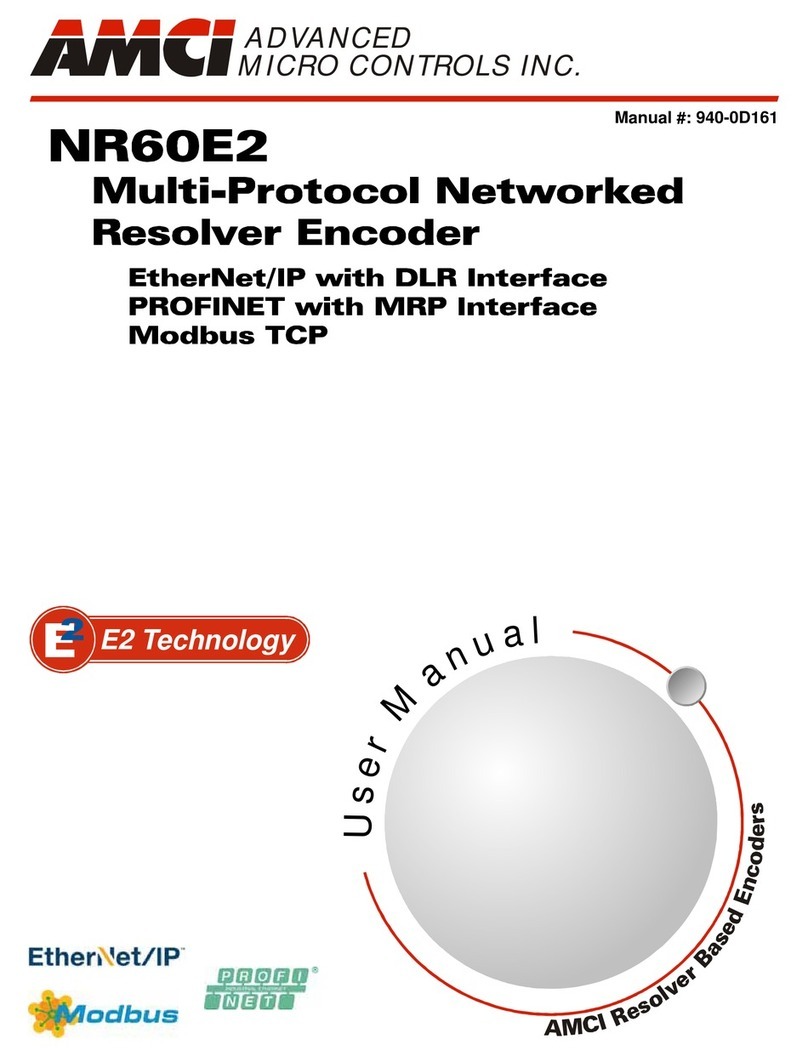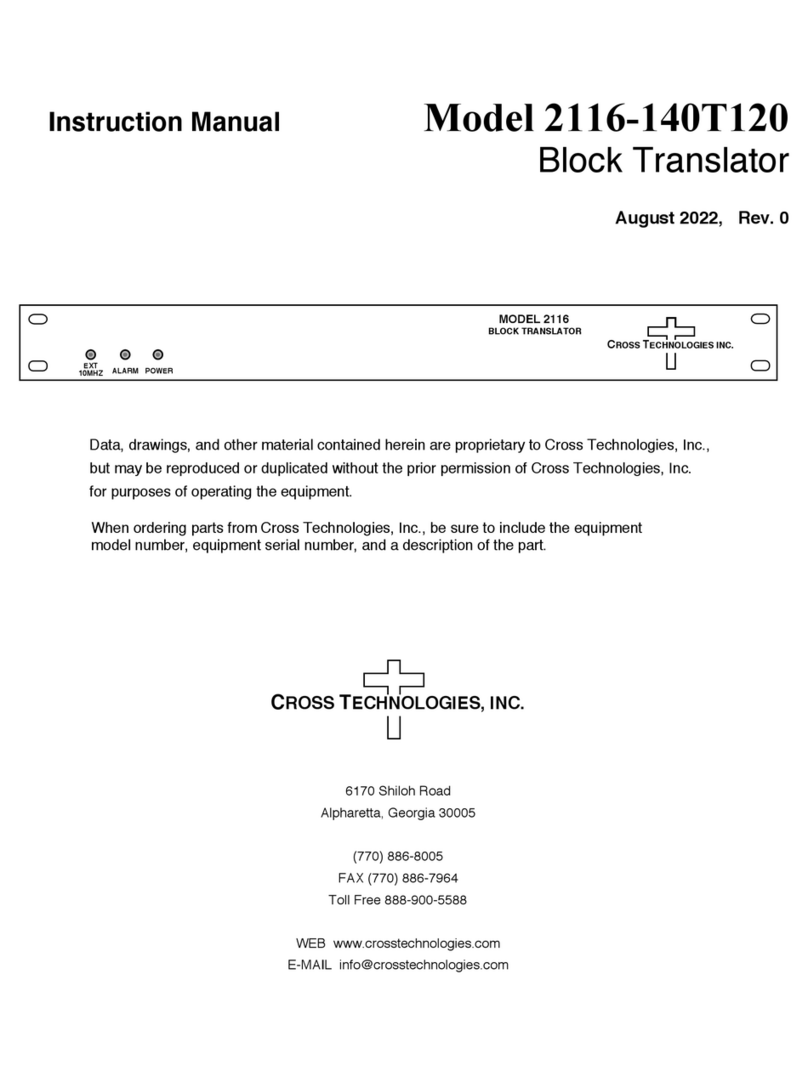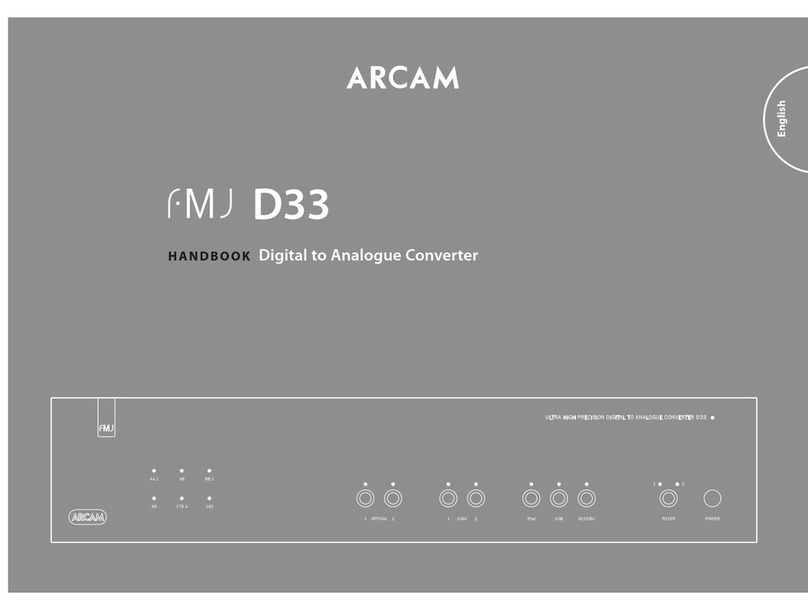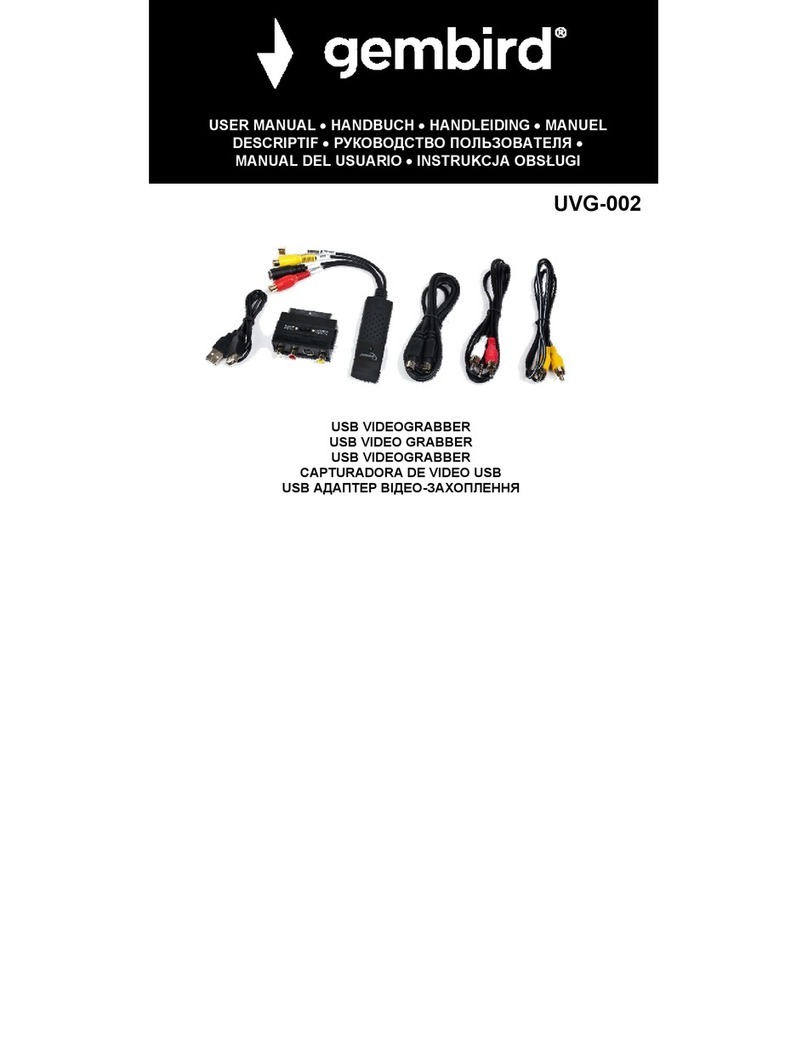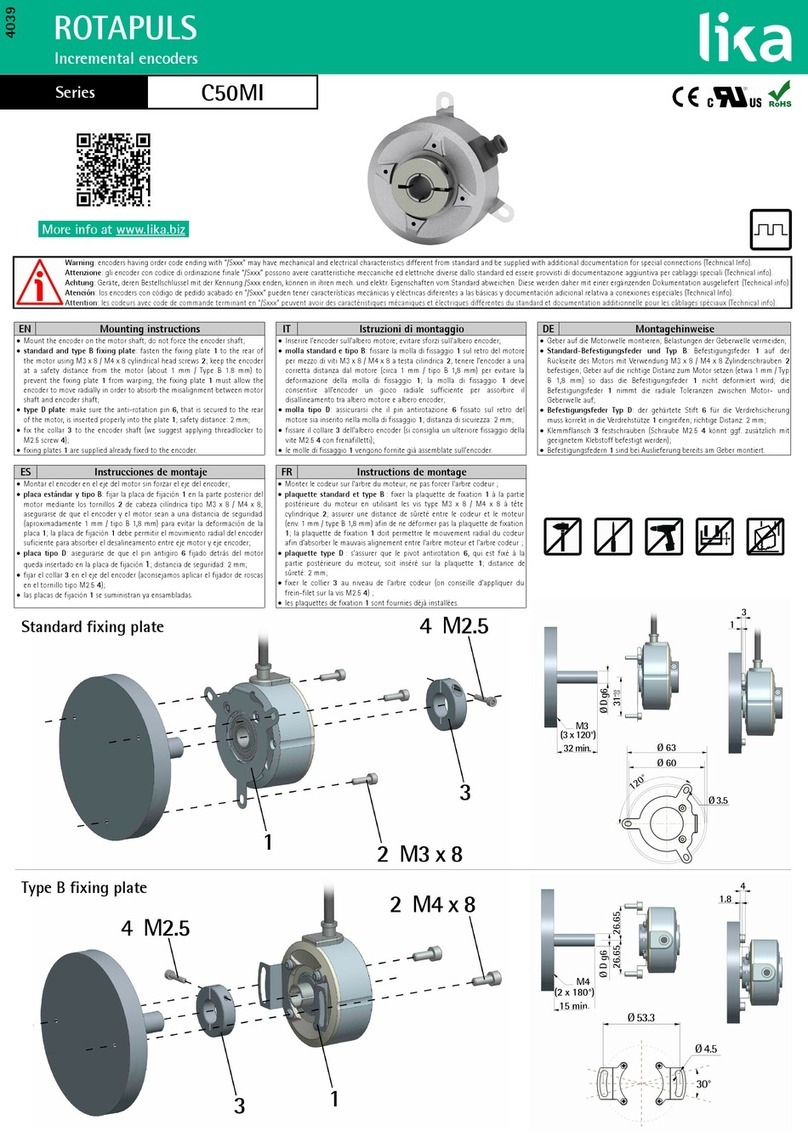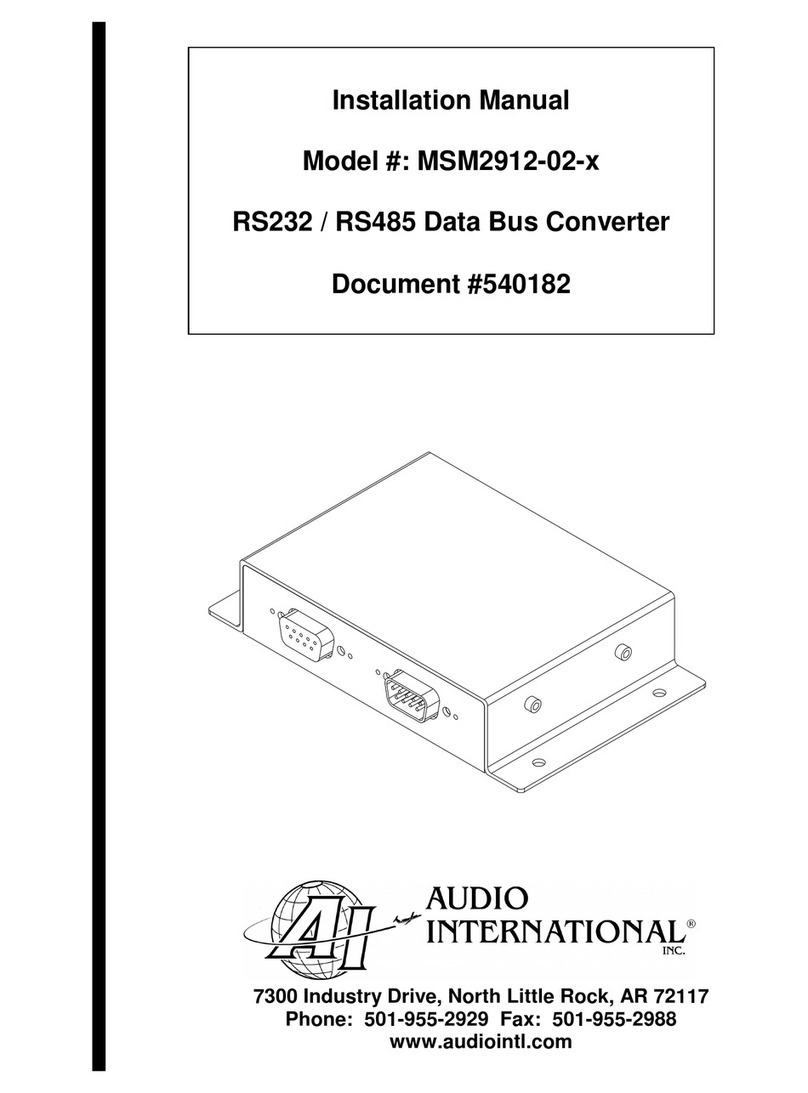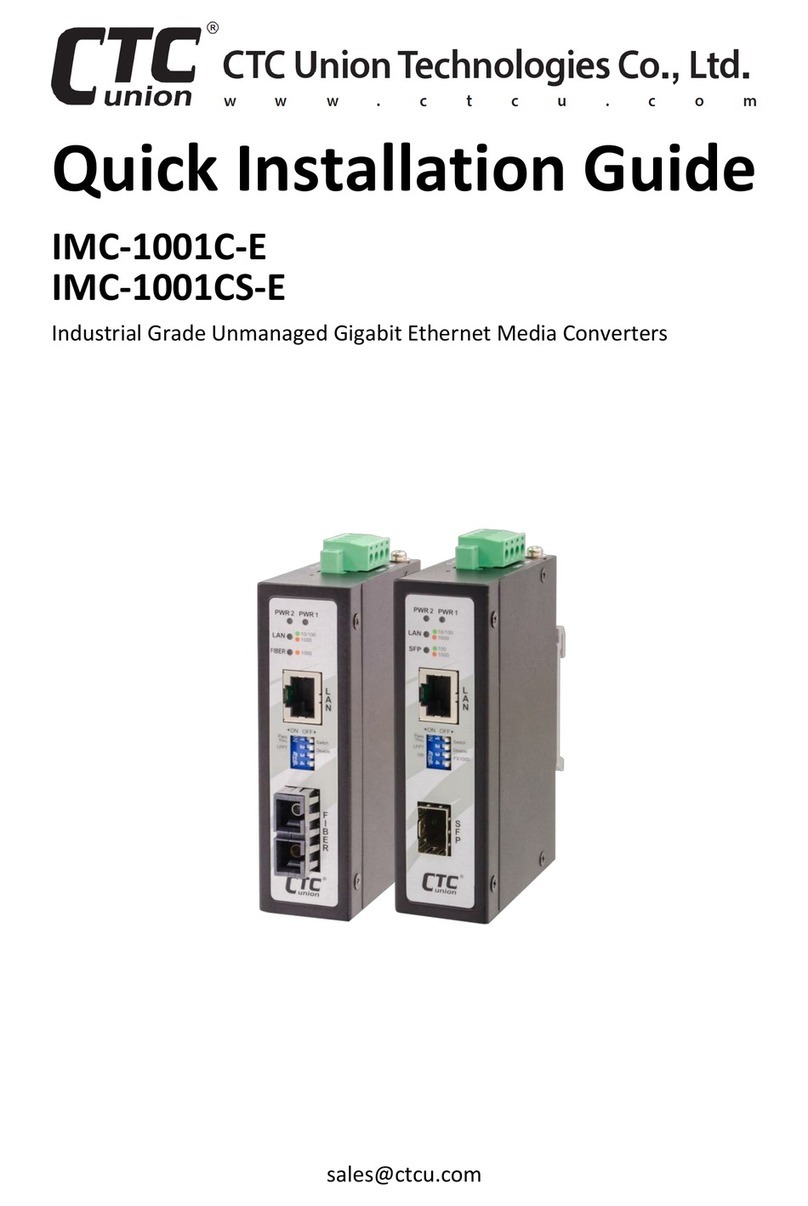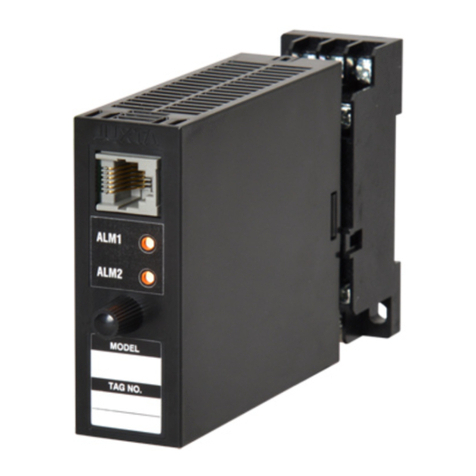Actox ABE30DC User manual

ABE30DC/ABE30DCF User Manual
Page 1 of 36
ABE30DC / ABE30DCF
30W Fan-less Ext. C-Band BUC
USER MANUAL

ABE30DC/ABE30DCF User Manual
Page 2 of 36
Table of contents
Introduction………………………………………………………………...5
Receiving and inspection……………………………………………………..6
Equipment Damage or Loss
Return of Equipment
Preparing for installation………………………………………………….…..7
Safety Precautions
General description……………………………………………………….…..8
Considerations
Securing the Block Up Converter
Installing the Block Up Converter……………………………………………………..…...9
LED Indicators, Connector Pin Assignment, 10Mhz Reference
Powering Options, Setting L.O., Setting Tx/Rx Frequencies
Recommended Test Equipment…………………………………………………………...13
Technical Specifications……………………………………………………..14
Assembly and Installation……………………………………………………15
Connections and Mounting Hardware
Functional Overview…………………………………………………………16
General
IF/RF Conversion and Amplification
Monitor and Control (optional)
Operation Procedure………………………………………………………...17

ABE30DC/ABE30DCF User Manual
Page 3 of 36
Maintenance……………………………………………………….........….18
Preventive Care
Procedure
Block Up Converter Cooling System Preventive Maintenance
Performance Check
Troubleshooting
Out-of Warranty Repair
Appendix 1 Mechanical Drawing……………..……………………………....20
Appendix 2 Spare Parts Order Form………………………………………….21
Appendix 3 M&C Commands…...……………………………………………..22
Appendix 4 BUC pin connectors……………...………………………………….27

ABE30DC/ABE30DCF User Manual
Page 4 of 36
Scope
This document covers the installation, operation, and maintenance of the ABE30DC BUC. It contains
information intended for engineers, technicians and operators working with the block up converter.
To make inquiries, or to report errors of fact or omission in this document, please contact Actox
Corporation at toll free 866-888-6087.

ABE30DC/ABE30DCF User Manual
Page 5 of 36
INTRODUCTION
The ABE30DC is a reliable, high quality, cost efficient stand-alone block up converter. The application
for this block up converter is C-Band VSAT communication in an outdoor environment. This line of
superior products, engineered using state of the art technology, is characterized by unparalleled durability
and dependability.
This is the smallest and lightest 30W L-To C-Band Block Up Converter and is designed to be mounted on
the feed horn. The unit is ideal for portable and mobile applications. This unit is powered with 15-60
VDC and consumes 107W at 45dBm.
KEY FEATURES
5.850 – 6.725 GHz
L.O. 4.9 GHz
Smallest package size and weight
Auto-ranging power 15-60 VDC
Low power consumption (107W)
Digital temperature compensation
Internal 10MHz high stability reference (optional)
Power and lock LEDs
Advanced M&C – combined RS-232/485
FSK(optional)
RoHS compliant

ABE30DC/ABE30DCF User Manual
Page 6 of 36
Receiving and Inspection
The block up converter is designed to function outdoors and will arrive in a standard shipping container.
Immediately upon receipt of the block up converter, check the packing slip against the actual equipment
you have received. Inspect the shipping containers exteriors for visible damage incurred during shipping.
CAUTION!
Handle the block up converter with extreme care. Excessive shock may
damage block up converter’s delicate internal components.
Using the supplied packing list, verify that all items have been received and undamaged during shipment.
Verify that all items are complete. If there are any omissions or evidence of improper packaging, please
notify Actox Corporation immediately.
Equipment Damage or Loss
Actox Corporation is not responsible for damage or loss of equipment during transit. For further
information, contact the responsible transport carrier.
When declaring equipment as damaged during transit, preserve the original shipping cartons to facilitate
inspection reporting.
Return of Equipment
When returning equipment to Actox Corporation for repair or replacement:
1. Identify, in writing, the condition of the equipment,
2. Refer to the Invoice, Purchase Order and the date the equipment was received.
Notify Actox Corporation RMA department of the equipment condition and obtain a Return Material
Authorization (RMA) number and shipping instructions.
NOTE
Do not return any equipment without an RMA number. This is
important for prompt, efficient handling of the returned equipment and of
the associated complaint.

ABE30DC/ABE30DCF User Manual
Page 7 of 36
Preparing for Installation
Before attempting to install or use the block up converter, we recommend that you first familiarize
yourself with the product by reading through this manual. Understanding the operation of the system will
reduce the possibility of incorrect installation, thereby causing damage or injury to yourself or others.
The block up converter must be installed in accordance with the
conditions and recommendations contained in the following sections.
Safety Precautions
Carelessness or mishandling of the block up converter may damage the unit causing serious injury to
yourself or others. Please adhere to the following:
WARNING!!
If your unit is equipped with an AC power cord and plug, do not tamper
with, or attempt to reconfigure, the cord or plug supplied with the unit,
as this can: result in personal injury, void the warranty, cause damage to
the units or related equipment.

ABE30DC/ABE30DCF User Manual
Page 8 of 36
INSTALLATION AND OVERVIEW
General Description
This section describes the installation and theory of operation of the block up converter.
ABE30DC is powered by 15-60 VDC via IF connector.
It will amplify an input signal from an L-Band RF source up to a power level of 30 Watts (min) CW in C-
Band.
The block up converter can be used as a stand-alone unit or in a redundant configuration.
Specifications
Table 1 summarizes the specifications of the ABE30DC BUC. For mechanical specifications, refer to the
outline drawing, Appendix 1.
General Considerations
The block up converter shall meet all specifications over full bandwidth and under all environmental
conditions when terminated with a load of VSWR at 1.5:1 unless otherwise specified. All RF
specifications shall be met within five minutes after applying power, except gain flatness, which shall be
met after a warm-up period of ten minutes. During the warm-up period, the block up converter shall not
exhibit any alarm or require an RF mute input signal to reset any alarm/fault latches.
Securing the block up converter
Align the block up converter output waveguide flange with the mating flange of the antenna feeder
waveguide. Using the O-ring and hardware provided, connect the antenna feeder waveguide. Torque the
flange screws to 16 inch-pounds (1.8 N-m). Attach the proper cables for waveguide for IF input, AC
power and M&C if equipped to the corresponding connectors of the block up converter.
The cylindrical connectors are labeled clearly and have different pin layouts. It is
impossible to incorrectly install the mating connectors.

ABE30DC/ABE30DCF User Manual
Page 9 of 36
Installing the Block-Up Converter
Tools and Test Equipment
Have on hand a standard electrician's tool kit and any tools listed in the antenna
manufacturer's installation instructions.
Site Considerations
The BUC is designed to mount on the antenna. Locate and install the antenna according
to instructions supplied by the antenna manufacturer. Choose an area that is free of
extraneous interference from motors and electrical equipment and has a clear line of sight
from the antenna to the satellite. Lightning arrestors should be used at the site to protect
personnel and equipment.
Preparation
Mounting Considerations:
Optional Mounting Brackets are available that will facilitate mounting for most antennas.
The ODU must be mounted such that:
- Sufficient support is afforded to the BUC, the LNB and the Power supply to minimize
the effects of antenna sway in strong winds.
- Air movement across the heat fins is possible.
- The length of the Power supply cables is taken into consideration in determining the
mounting location of the power supply.
Throughout installation and during any polarization, azimuth or
elevation adjustment, ensure that cables and waveguide are not crimped
or pinched.

ABE30DC/ABE30DCF User Manual
Page 10 of 36
LED Indication
SSPA LED GREEN SSPA OUT ENABLED
SSPA LED RED SSPA OUT MUTED/LOW L-BAND
INPUT
L.O. LED Green L.O. is set to 4900MHz
NO POWER
10MHz is Detected
10MHz is Absent
NO LED indicators
10MHz LED Green
10MHz LED Red
Connectors' Pin Assignment
Connector Type Pin # Signal Parameter
J1 "IF IN" F-type female N/A IF Input -0 dBm, max
10 MHz
Ref. IN ±5 dBm
J2 "RF OUT" CPR-137 N/A RF Output 45.0 dBm min

ABE30DC/ABE30DCF User Manual
Page 11 of 36
M&C Connection for 19-Pin
19 pin conn 9 pin conn
GND G -----------------------5
TX 232 J ------------------------2
RX 232 E -----------------------3
The following should be set on the COM Port:
Baud Rate: 9600bps
Data bits: 8
Stop bits: 1
Parity: None
HW Control: None
INTERFACE_19PIN Connector
X1 (19 pin)
Signal type Signal Name Pin Description
Ethernet RX_P C
Ethernet RX_N P
Ethernet TX_P L
Ethernet TX_N N
GND GND G
RS-422/485 TX_B H
RS-422/485 TX_A T
RS-422/485 RX_B F
RS-422/485 RX_A S
RS-422/485/232 GND RS_GND G
RS-232 TX_RS-232 J
RS-232 RX_RS-232 E
Control - TTL /MUTE_IN M To Mute short Pin M & Pin V
Monitor - TTL ALARM_IZ B Summary Fault -Alarm - TTL
Low
Monitor - Analog (0 to 5V) P_OUT_OUT D U=4,5V +- 0,5V
- Pmax
Monitor/Control GND WIRE_GND V

ABE30DC/ABE30DCF User Manual
Page 12 of 36
10MHz Reference
The BUC must receive a stable external 10MHz reference provided by a stable signal source such as a signal
generator, satellite modem or injected externally with a Bias T (for example, ABT6ARN/ABT6ARF manufactured
by Actox Corporation) or a similar bias T type. Optional 10MHz reference option is enabled.
Please make sure to check the sticker on the BUC for the appropriate power source before any power
connections are performed.
Powered via IF Universal 15-60VDC
An IF powered unit is powered through IF coaxial input connector (F or N type) by an external
minimum 30W 24VDC or 48VDC power supply source.
Powered via only MS 15-60VDC (optional)
MS only powered unit uses a 2-pin MS mating connector (which is included with the BUC) with
either a 24VDC or 48VDC external power source with at least 30W.
Powered via AC 80-240VAC (optional)
The AC only powered unit has a 3-pin AC connector (which is included with the BUC) and this
unit must have its own dedicated power AC plug in power source.
Setting the TX and RX Frequencies
All transmit and receive frequencies are set in the modem.
For a direct connection to an L-band modem follow the manufacturer’s
instructions on setting the transmit and receive frequencies.
Ensure that it is safe to transmit prior to enabling the transmission.

ABE30DC/ABE30DCF User Manual
Page 13 of 36
Recommended Test Equipment
The following equipment or equivalent is recommended for installation and system
alignment:
Equipment Type
Spectrum Analyzer HP8563E
Digital Voltmeter Fluke 8050
Adapter Waveguide to coax C or Ku-band
RF cables With calibrated insertion loss up to 15GHz
40 dB attenuator High Power to match HPA output.
Assortment of cables, connectors and adapters (calibrated up to 15 GHz)
Ensure that the BUC TX output power is disabled to prevent accidental transmission interference with
adjacent satellites or transponders before attempting to align or performing any other operation
involving the ODU. Before attempting any system change, carefully evaluate the possible effects of the
transmitted signal.

ABE30DC/ABE30DCF User Manual
Page 14 of 36
Table 1. Specifications
TECHNICAL SPECIFICATIONS
RF frequency 5.850 to 6.725 GHz
Local oscillator 4.90 GHz
IF frequency 950 to 1,825 MHz
Output power 30W (+45 dBm min.), P-Linear 15.7W (41.9 dBm min.)
IF connector N-type or F-type (field-exchangeable)
Power supply : auto-ranging via IF connector +15 VDC ~ +60 VDC via IF cable 107W max.
Output interface CPR 137 G
Gain 68 dB nominal
IMD3 (two tones) -26 dBc max. 2 signal 5 MHz apart at P-LINEAR
L.O. leakage -45 dBm max
Spurious -53 dBc max
Spectral regrowth
(QPSK at 1.5x and OQPSK at 1.0x symbol rate offset
with 2dB back-off from rated output power) -30 dBc
Requirement for external reference:
frequency
input power
via IF cable
10 MHz (sine-wave)
-5 to +5 dBm @ input port
TX Gain variation
TX Gain stability over temperature range
±0 .5 dB over 40 MHz
±1.8 dB over full band
±1.5 dB typ., ± 1.8 dB max.
Phase noise
(Exceeds Intelsat’s standard IESS308/309)
-55 dBc/Hz max. @ 10 Hz
-65 dBc/Hz max. @ 100 Hz
-75 dBc/Hz max. @ 1 KHz
-85 dBc/Hz max. @ 10 KHz
-95 dBc/Hz max @ 100 KHz
-115 dBc/Hz max @ 1 MHz
Noise power density Transmit
Receive -66 dBm/Hz (max)
-157 dBm/Hz (max)
Noise figure 15 dB max
Input V.S.W.R. 1.5 : 1 max
Output V.S.W.R. 1.5 : 1 max.
Mute Shut off the HPA if L.O. unlocked
Status LED
10MHz Reference LED GREEN
GREEN blinking
RED
Alarm LED GREEN
GREEN blinking
RED
L.O. LED GREEN
External Reference - OK
Internal Reference - OK
Reference Alarm
OK
Mute
Summary Alarm
All OK standard 4.9 GHz
Temperature range (ambient)
operating -40 deg C to +55 deg C
storage -55 deg C to +85 deg C
V
ibration and shock Complies with MIL-STD-810E
Dimensions & housing 216.5 (L) x 120 (W) x 87 (H) mm
8.66” (L) x 4.8” (W) x 3.48” (H)
Weight 2.76 kg (6.1 lbs) max

ABE30DC/ABE30DCF User Manual
Page 15 of 36
Connections and Mounting Hardware
The IF input connection requires a coaxial cable with an F or N type connector. The RF output requires a
waveguide with a WR-137 flat flange. An O-ring shall be used to seal the waveguide connection.
Assembly and Installation
Use the information in this section as a guide to assemble and install the block up converter. The
specified humidity is up to 100% during operation. However, installation should be carried out in dry
conditions, free of salt spray or excessive humidity. This will eliminate the possibility of moisture and
other foreign substances from entering the output waveguide flange.
CAUTION!
Only authorized technical personnel should perform the Installation and
proper electrical hookups of the block up converter.
The block up converter is designed to operate in an outdoor environment and is waterproof when mounted in the
correct orientation.

ABE30DC/ABE30DCF User Manual
Page 16 of 36
Functional Overview
General
This section describes the block up converter functions in detail. The functional overview explains the
RF amplification, monitor & control and power distribution.
IF/RF Conversion and Amplification
The IF Input requires a signal with a 10MHz reference, and 15-60 VDC power source. 2-4.5Amps
nominal enters the BUC by a coaxial cable, converted to C-Band by the BUC and goes through an
internal isolator and reject filter, which provides a good VSWR at the input and minimizes spurious on
receive band 3.4-4.2GHz. Under normal operation, the RF amplifier will amplify the RF Input signal
level up to a power level of 45 dBm 30 Watts CW minimum.
To achieve the rated output power of the RF Amplifier, provide the necessary gain and low insertion loss.
The amplified signal is transmitted through the output waveguide section to a satellite up-link system.
Monitor and Control
The block up converter may have a RS-485 and RS-232 serial interface. With this option the block up
converter can communicate to the indoor unit or redundancy control block up converter via RS-485 or
RS-232.
The control system can provide the following M&C functions:
BUC Alarm (via RS-485/RS-232): when an input BUC within the block up converter system
current draw is below 0.3A, a BUC alarm signal will be transmitted via the RS-485/RS-232 serial
interface.
Mute Control (via RS-485/RS-232)
Mute Control (via hardware line): TTL high level signal will mute a block up converter
Output Power Monitoring: 15 dB dynamic range (via RS-485/RS-232)
Base Plate Temperature Monitoring (via RS-485/RS-232)

ABE30DC/ABE30DCF User Manual
Page 17 of 36
Operation
It shall be performed by authorized personnel prior to maintenance and/or repair.
Procedure
Verify that the installation procedure described was completed. A complete physical check of the
customer’s system is suggested.
WARNING!!
The output power available at the output waveguide flange is extremely
hazardous. Under no circumstances should block up converter be
operated without the waveguide feed or a high power load attached. Do
not operate this equipment in the presence of flammable gases or fumes.
Failure to observe this precaution will result in personal injury. Safe
and careful installation of this block up converter will eliminate the
possibility of accidents and provide years of top performance.
Verify the antenna feed waveguide connection is properly done before the block up converter is
energized.
NOTE
The block up converter can withstand any source or load VSWR.
However, the block up converter will meet all specification requirements
only if the source/load VSWR is sufficient. Normal operation is not
possible if the antenna feeder VSWR is greater than 1.5:1.
Turn ON the power and allow a warm up period of twenty minutes before operating the block up
converter. This will assure stable gain and power. The block up converter can function with a coupler
when a direct measurement of the output power is made.

ABE30DC/ABE30DCF User Manual
Page 18 of 36
Maintenance
This section contains information on how to maintain, troubleshoot and repair the block up converter. The
block up converter is extremely reliable, requiring very little preventive maintenance, or repair. Should
there be a malfunction, this section also contains technical information to help diagnose basic failures.
Preventive Maintenance
WARNING!!
Shut down the block up converter before disassembly and remove all
cables and connectors. Failure to observe this precaution may result in
personal injury or death. This includes the removal of any RF power
originating from other system components.
When the block up converter is in the hot stand-by mode in a redundant system, switch it to the
operation mode at least once every three months.
When the block up converter is in the cold stand-by mode in a redundant system, switch it to the
operation mode at least once every three months.
Block up converter Cooling System Preventive Maintenance
Preventive maintenance is limited to checking the performance of the block up converter cooling system.
No electrical or mechanical adjustments are required for normal operation.

ABE30DC/ABE30DCF User Manual
Page 19 of 36
Performance Check
Verify the system is properly set up. The maximum output power at compression shall be measured for
evaluating the performance of the block up converter.
It is recommended to measure the following parameters for ensuring that the block up converter is in
good working condition:
-Gain and Gain flatness
-RF load VSWR and RF source VSWR
-Two-Tone Inter-modulation Distortion
-Return Loss at connectors of the block up converter
Using a Source and an IF input signal level within the small signal region of the block up converter,
measure the power level at connectors IF or MS connector. Plot the swept response on a test data sheet.
From the plot, determine gain and gain flatness.
Plot the swept return loss for both the IF Input and RF Output signals on a test data sheet. From the plot
determine the return loss.
From the output power measurements determine the maximum output power. Record value on a test data
sheet.
Measure the Two-tone Inter-modulation Suppression using two equal signals separated by 5 MHz.
Record value on test data sheet.
WARNING!!
Cable connection and disconnection shall be done carefully to avoid
physical damage to the cables and connectors, which may cause
intermittent problems in the future.
Out-of Warranty Repair
A non-warranty and out-of-warranty repair service is available from Actox Corporation for a nominal
charge. The customer is responsible for paying the cost of shipping the BUC both to and from Actox
Corporation for these repairs.
Symptom Action
Fails performance test Check power source, RF source, cabling and connectors. Check LED
indicators for status and if the light is red contact Actox Corporation. If we
are not able to assist you remotely, return block up converter to Actox
Corporation after RMA number has been issued.

ABE30DC/ABE30DCF User Manual
Page 20 of 36
Appendix 1
Mechanical Drawing
This manual suits for next models
1
Table of contents
Other Actox Media Converter manuals
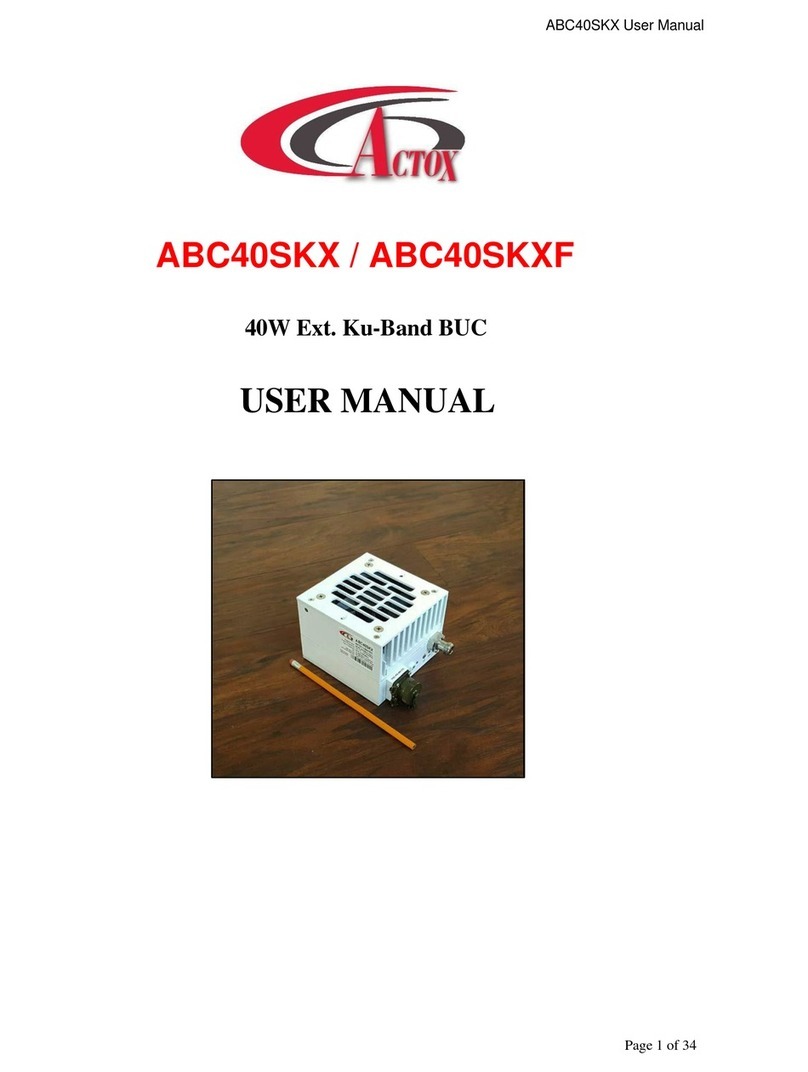
Actox
Actox ABC40SKX User manual
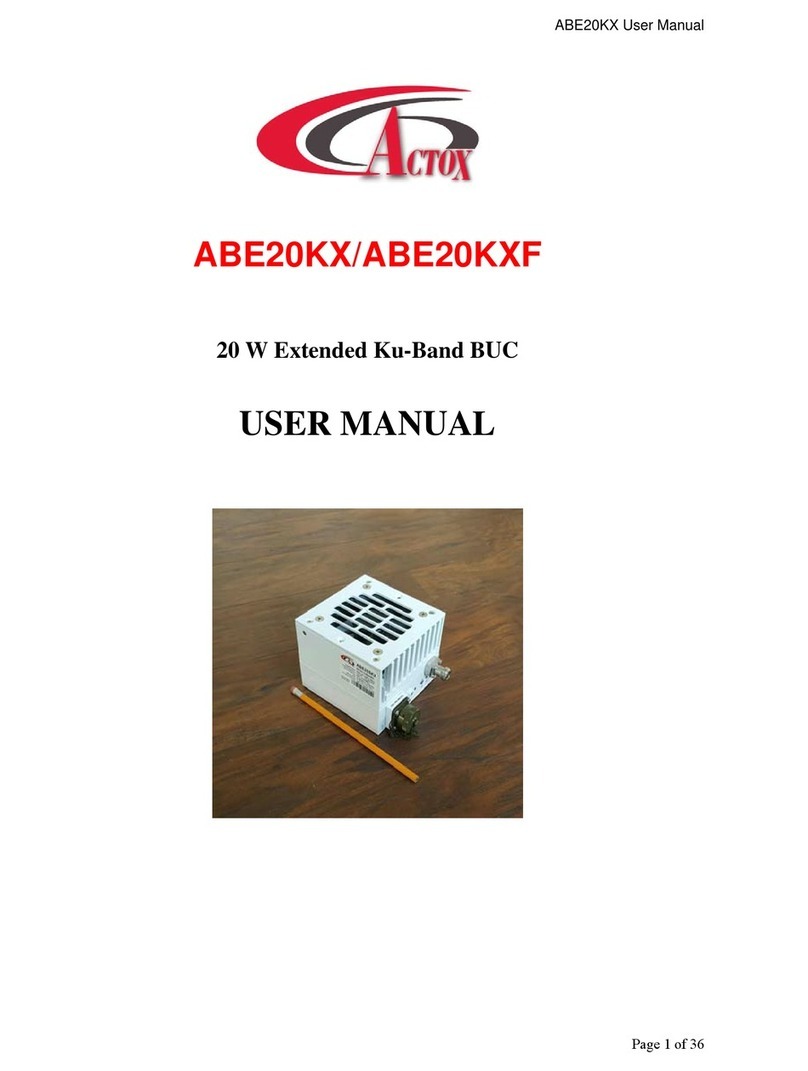
Actox
Actox ABE20KX User manual
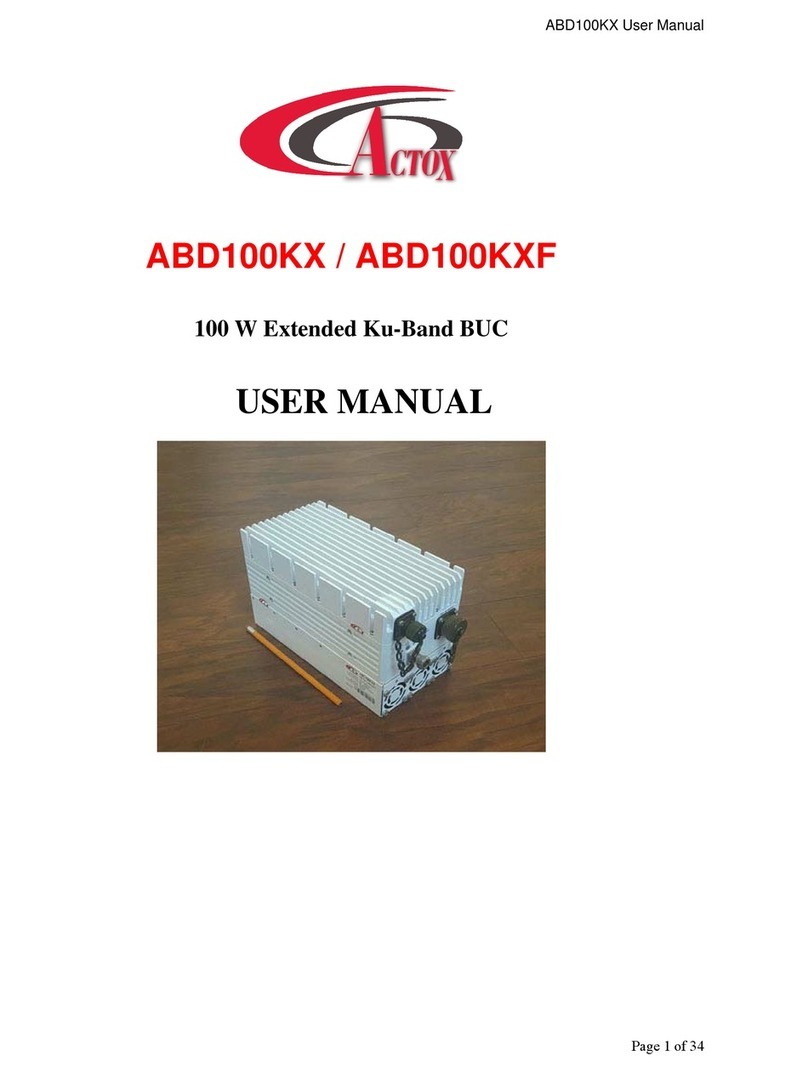
Actox
Actox ABD100KX User manual
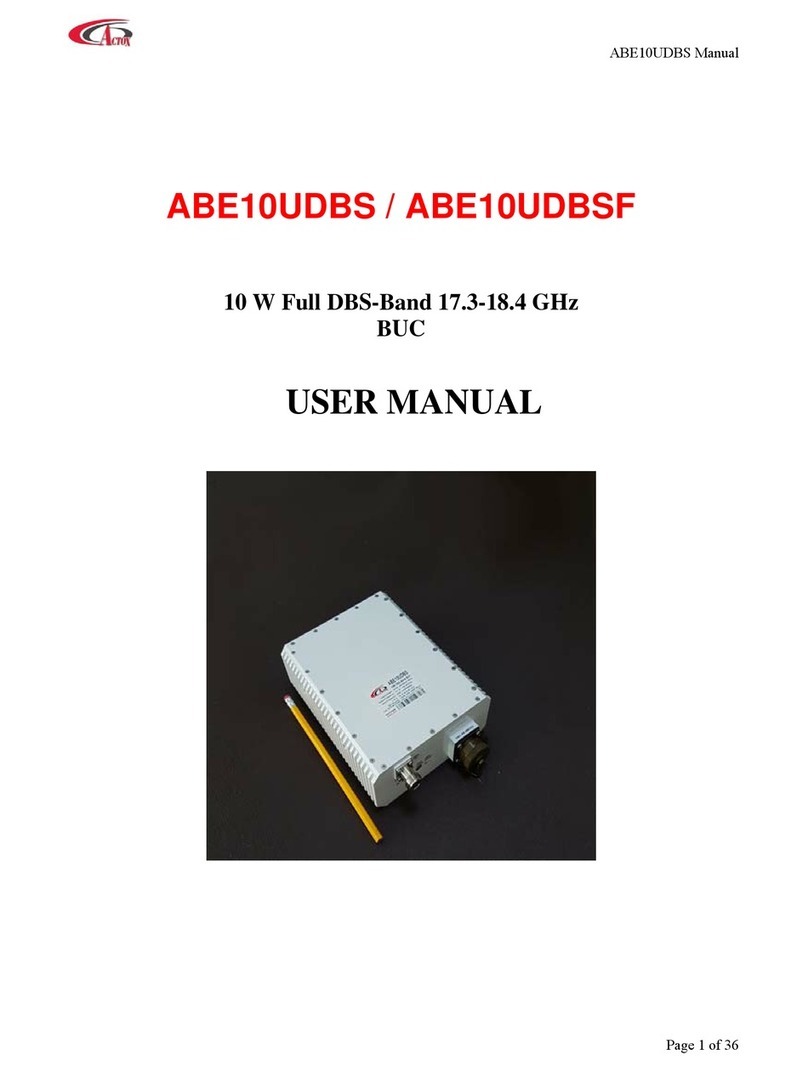
Actox
Actox ABE10UDBS User manual

Actox
Actox ABE12KX User manual
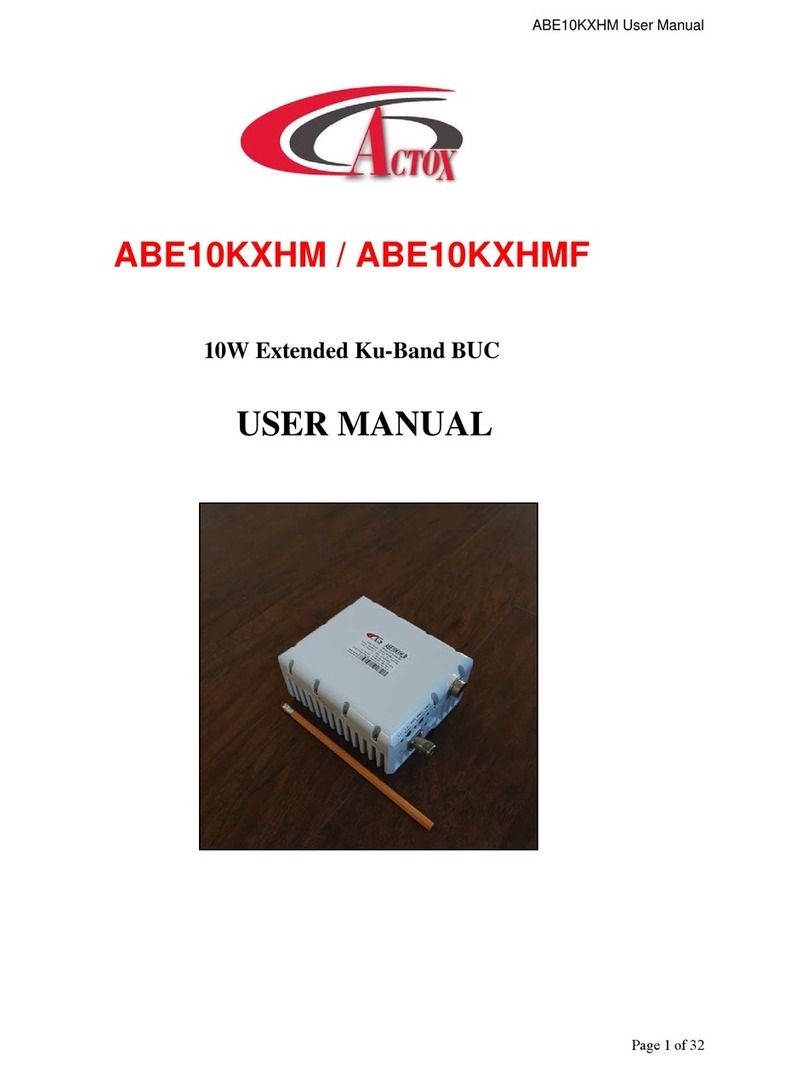
Actox
Actox ABE10KXHM User manual

Actox
Actox ABE25X User manual

Actox
Actox ABEN25KX User manual
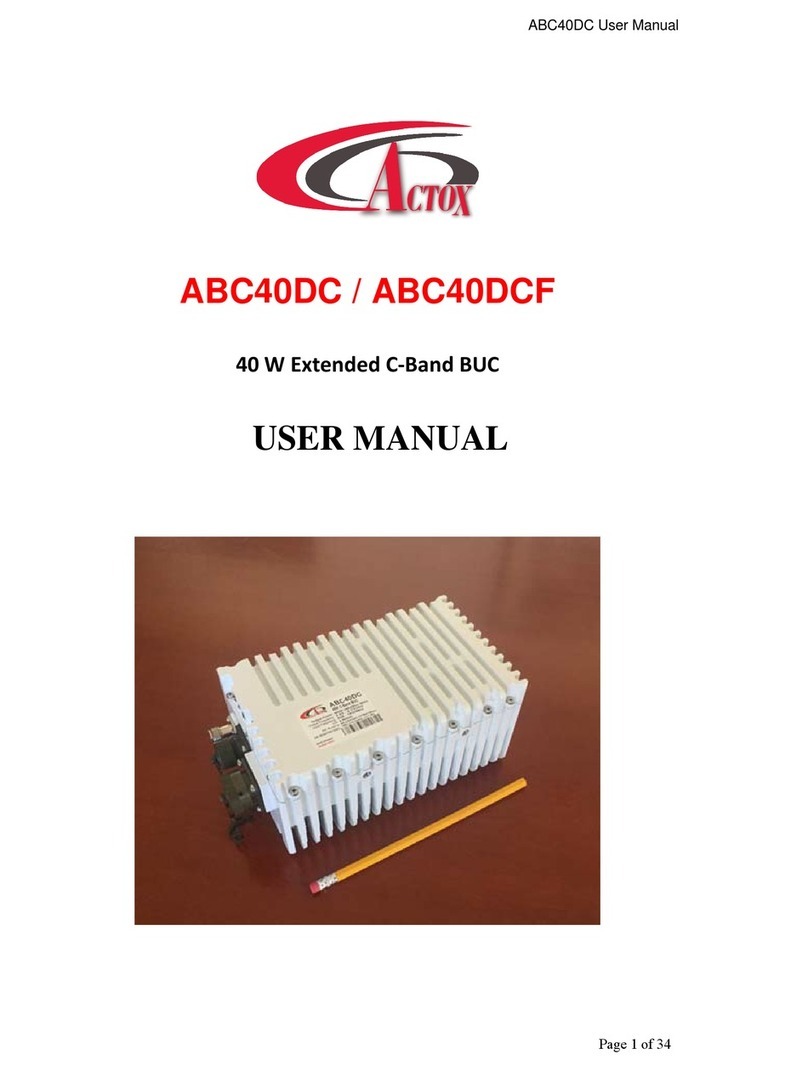
Actox
Actox ABC40DC User manual

Actox
Actox ABC25UKA User manual

